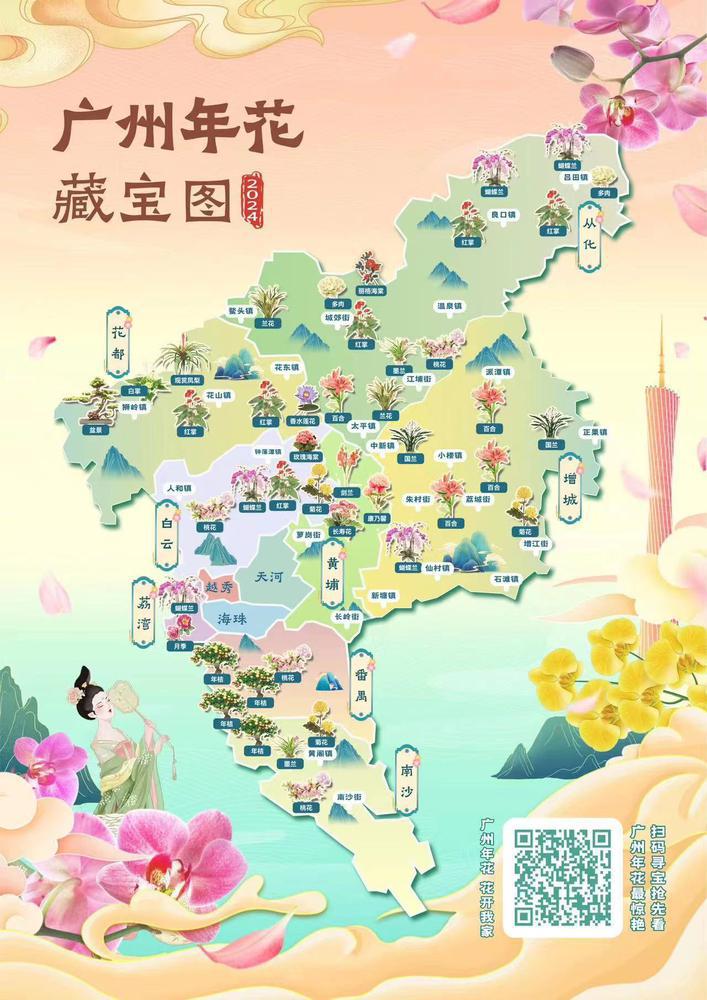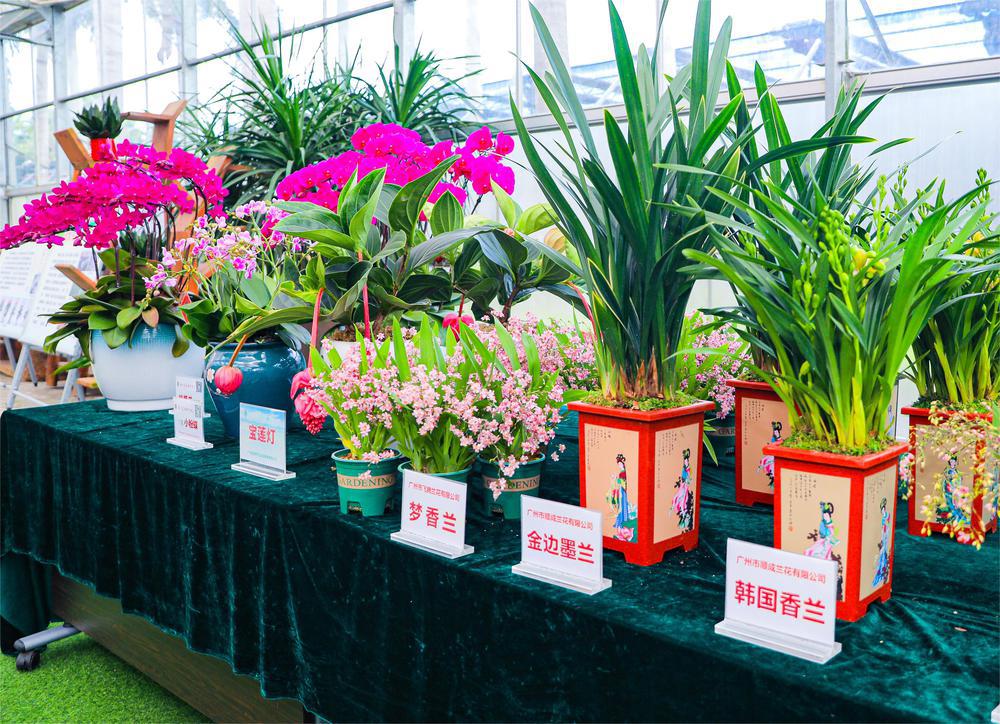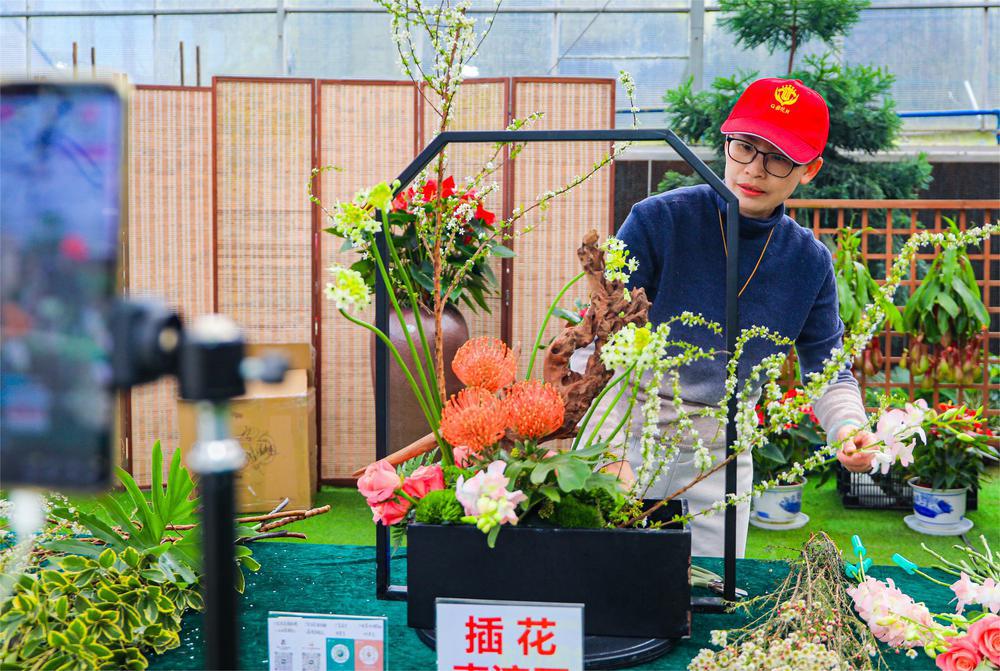
With the approaching Chinese Lunar New Year, the Spring Festival flower fair, an annual traditional cultural eventof Guangzhou, is set to be held as scheduled. Major flower growers and producers in various districts are actively preparing for the marketing of the New Year flowers.

On December 28th, accompanied by the splendid flower arrangement show by the florists, the 2024 Guangzhou New Year flower marketing event was held, during which the top ten recommended flower varieties for the New Year of 2024 as well as the "2024 Guangzhou Flower Treasure Map" were officially released, sparking the upcoming year's enthusiasm for flower appreciation and purchasing.

It is reported that in 2023, the planting area of flowers in Guangzhou reached around 350,000 acres, accounting for 30% of the province's total flower planting area. Flower planting and sales in the city are mainly distributed in eight districts, including Liwan District, Baiyun District and Panyu District.
During the Spring Festival flower fair, it is estimated that the total number of New Year flowers available for sale in Guangzhou will reach 15 million pots. In addition to the traditional tangerines, butterfly orchids, and peach blossoms, the main flower varieties for the New Year will also include winter jasmines, begonias, Chinese roses and so on.

In terms of the distribution of the flower industry, Conghua District in northern Guangzhou is known for anthuriums and potted plants; Baiyun District and Huadu Districts in central Guangzhou specialize in high-quality potted flowers and landscapes; Panyu and Nansha Districts in the south are known for foliage plants and green seedlings; Huangpu and Zengcheng Districts in eastern Guangzhou focus on perennial and bulb flowers and indigenous seedlings; and finally, Liwan District in the west is home to the flower circulation and trading center.
When it comes to the varieties, potted plants and ornamental seedlings serve as important pillars for Guangzhou's flower industry, accounting for over 83% of the total planting area. These competitive products are primarily exported to Europe, the United States, and Southeast Asia.
The "2024 Guangzhou Flower Treasure Map" contains information about 149 local flower growers and enterprises, and details about approximately 15 million potted flowers. By scanning the QR codes, people can learn about the address of each grower, as well as the varieties and quantities of flowers produced by them. Among all the varieties, butterfly orchids, tangerine trees, anthuriums, pineapple flowers, peach blossoms, Chinese orchids, peace lilies, poinsettias, boat orchids, and Rieger begoniashave been selected as the "Guangzhou's Top Ten Flowers for the New Year in 2024".
"Up to now, we have independently bred 92 new flower varieties, obtained 25 national Plant Variety Rights,one Community Plant Variety Right of the European Union, as well as six national invention patents. We have also created renowned 'Guangdong Flower' brands for self-developed new varieties such as 'Little Delicate Anthuriums' and 'Lucky Star Anthuriums'" said a representative from the Guangzhou Flower Research Center.
In recent years, through the integration of the primary, secondary and tertiary industries, Guangzhou's flower industry has been transforming from single production to the integrated development of production, sightseeing, leisure, and tourism. This has led to better support forthefarmers while providing more opportunities for them to achieve prosperity. Popular destinations for flower appreciation, such as the Million Sunflower Garden in the Nansha District, the Vanilla World in the Huadu District, and the Rose Garden in the Conghua District have emerged. Moreover, the flower industry is also expanding to the areas of food, cosmetics, and healthcare.
Currently, Guangzhou, with six large-scale flower markets, is an important national distribution center for flower products and a hub for imported flowers. The flower industry chain in Guangzhou has been showing regional advantage, cluster advantage, and marketization advantage.
Source:Yangcheng Evening News
约1500万盆(株)年花将亮相广州迎春花市!
中国农历龙年临近,广州一年一度的传统文化盛会——迎春花市即将如期而至,各区花卉种植大户、生产企业正在为年花营销积极“备战”。
12月28日,伴随花艺师精彩的插花表演,2024年广州年花营销推荐活动举行。活动现场,2024年广州十大年花主推品种正式发布,“2024年广州年花藏宝图”也同步发布,将掀起新一年“赏花”“买花”热潮。
据介绍,2023年广州市花卉种植面积约35万亩,约占全省花卉种植面积的30%。广州花卉种植、销售主要分布于荔湾、白云、番禺、花都、南沙、黄埔、从化和增城等8个区。
据介绍,本次迎春花市期间,预计广州全市年花上市数量总计约1500万盆(株),除传统的年桔、蝴蝶兰、桃花外,年花品种以红掌、水仙、剑兰、月季、百合、玫瑰花、迎春花、海棠花等为主。
从花卉产业布局上看,全市现已形成北部从化的红掌、盆栽植物,中部白云、花都的精品盆花及盆景,南部番禺与南沙的观叶植物和绿化苗木,东部黄埔、增城的宿根球根花卉和乡土苗木,以及西部荔湾的花卉流通交易中心的特色布局。
从品种上看,盆栽植物类和观赏苗木是广州花卉产业的重要支柱,种植面积合计约占83%以上,是广州花卉产业的主要拳头产品,产品主要出口欧洲、美国、东南亚等地。
“2024年广州年花藏宝图”内含广州本地149个花卉种植户及企业、约1500万盆(株)年花的相关信息,通过扫描二维码便知每一个种植户或企业的种植地址、品种、数量等。蝴蝶兰、年桔、红掌、凤梨花、桃花、国兰、白掌、一品红、大花蕙兰、玫瑰海棠入选2024年“广州十大年宵花优品”。
“我们中心至今已自主培育红掌等花卉新品种92个,获国家植物新品种权25个,获欧盟植物新品种权1个,获国家发明专利6项,在国内形成了‘小娇红掌’‘福星红掌’等自主新品种知名‘广花’品牌。”广州花卉研究中心有关负责人介绍。
近年来,通过推动花卉一二三产业融合发展,广州花卉产业已由单一生产型逐渐向集生产、观光休闲、旅游于一体型转变,发挥更好的联农、带农、富农作用,涌现了南沙百万葵园、花都香草世界、从化宝趣玫瑰世界、天适樱花悠乐园等热门花卉观赏旅游景点。此外,花卉还不断向食用、洗护、保健等功能拓展。
目前,广州拥有广州岭南花卉市场等6个大型花卉市场,是全国花卉产品重要集散地和进口花卉的调运中心,花卉产业链逐渐显示出区域优势、集群优势和市场化优势。
文|记者 许悦 通讯员 穗农宣
图|受访者供图
翻译|洪婷
-
2023 Review: China's 'eight vertical and eight horizontal' railway network reaches 80% completion
2023-12-29 21:10:49 -
Y Talk㊸| What did we do in 2023? 回望2023,我们做了什么?
2023-12-29 15:07:46 -
Video|Italian doctor Enrico Randi: A journey of Tai Chi from Guangdong to Bologna
2023-12-29 15:04:06 -
Baiyun Airport handles 2 mn tons of cargo in 2023
2023-12-28 22:13:33






